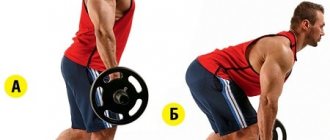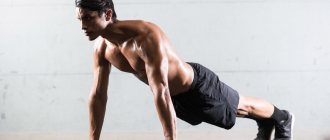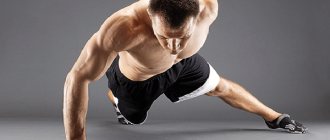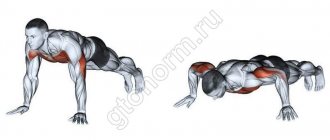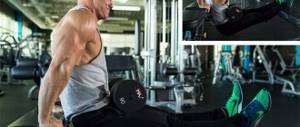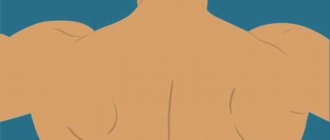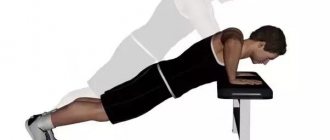What muscles work?
To understand the mechanism of correct execution of the exercise, you should first understand which muscles work when doing push-ups on one arm? In general, the same muscle groups that are involved in regular push-ups are included in the work:
- pectoralis major muscles;
- triceps;
- deltoid muscles;
- biceps;
- rectus and oblique abdominal muscles;
- serratus anterior muscles;
- gluteus maximus muscles;
- hamstrings;
- quadriceps;
- calf muscles;
- latissimus dorsi muscles.
The difference between the options is the accentuated load on certain muscle groups. In the “one-handed” version, the calves, hamstrings and quadriceps play a less important role. At the same time, the load on the lats increases significantly. Since one of the key points of support is lost, the body requires stabilizers to balance. In this context, the latissimus belongs specifically to the stabilizing muscles.
The role of certain muscles increases or decreases depending on the position of the body, arms, pelvis and legs. The closer the execution technique is to ideal, the greater the load on the triceps, deltoids, abs and stabilizers. The ideal technique is the one that requires the most effort. More about this in the appropriate section.
Breath
The exercise is challenging and can drain your strength quite quickly. To make the process easier and more effective, make sure you breathe properly while moving. Inhale as you lower. This will allow your chest to relax.
Exhale as you return to the starting position. As you push up, releasing air helps tighten your abdominal muscles, making the push-up motion of your body much easier. Controlling your breathing with proper technique is the key to performing successful push-ups .
Benefits and Benefits of Exercise
One-arm push-ups are an exercise that will make you much stronger and more resilient. Thanks in part to Paul Wade, author of The Training Zone, these movements became known as prison push-ups. Paul spent many years in prison, where he was able to develop enormous strength almost exclusively through bodyweight training. And push-ups played a major role in developing Wade's core strength.
Although the prisoner did not practice lifting weights, one day he became embroiled in a curious argument. The author of a motivational book was offered to speak at one of the powerlifting championships. In an effort to prove the superiority of the inventoryless system, Paul agreed to the bet. Without much experience with the barbell, he managed to take third place. This is the effect of powerful exercises designed for natural loading.
Strength growth
Regular push-ups quickly become a simple exercise that can be increased in intensity, mainly by increasing the number of repetitions. Eliminate one hand, and the load increases by an order of magnitude. Try to make the movement perfectly, and “physics” will add more order on top. Nobody can ever call people who can do push-ups on one arm weak. At least their feet have never crossed the threshold of the gym.
Increased stamina
Over time, as physical capabilities increase, the same situation occurs as with the “classics”. The body adapts to the load and responds to training by increasing endurance. Athletes who are capable of repeated single push-ups have excellent body control and get much less tired under normal conditions than mere mortals.
Ability to work out anywhere
If a prisoner in solitary confinement has managed to become a titan of “physical education,” then complaints about the lack of suitable conditions look ridiculous and pathetic. The benefit of one-arm push-ups is that they can turn an untrained person into a role model in a matter of months.
Paul Wade went to prison at age 23. With a height of 183 cm, he weighed only 68 kg. It’s not easy in dungeons with such parameters. But, having begun to train intensively, within a year he was one of the strongest prisoners. Wade is not alone - his “colleagues” often surprise with their physical capabilities. His example and examples like him are indicative - they demonstrate the potential of bodyweight training. By the way, on our website in the crossfit exercises section you can find many exercises for working with your own weight.
Balance
Advanced push-ups require coordinated muscle action. Along with strength, the ability to control your body also grows. The body “learns” to work as a monolith - some groups are closely connected to others. An excellent example of a person who subordinated “physics” to consciousness is Bruce Lee. Little Dragon also did a lot of push-ups.
Bruce Lee's record for push-ups on one hand (on two fingers) is 50 times. Partly thanks to this, he became a “spring man”, ready and able to move to another position at any moment, like a cat.
Weight loss
Push-ups are an energy-intensive exercise. By regularly testing your body's strength, you can make rapid progress in losing weight. Now the plank has become fashionable - an effective abdominal exercise. But with push-ups, you're essentially doing the same plank in motion. Without support from the second hand, it is more difficult to do the exercise, and therefore the impact is higher.
Improved health
Regular one-arm push-ups help improve the functioning of the digestive system. Thanks to them, the heart is strengthened and the potential of the respiratory system increases. They have a beneficial effect on bones and ligaments - they become stronger.
Positive psychological impact
Few people can technically do push-ups on one arm. Agree, it’s nice to be part of a small group of athletes. You may be indifferent to the envy and admiration of others, but in any case you will have the right to be proud of yourself.
Execution technique
There are many variations of this exercise. Some of them are designed for beginners, others are only suitable for advanced athletes. Let's consider the technique of the classic, most complex, version. Starting from it, you can reduce the load - this allows you to master the movement gradually, regardless of your starting capabilities.
The standard option resembles regular push-ups. The visual difference is only in the “disabling” of one hand. No one can do it right away, no matter how much physical strength the athlete has. This requires special skills and “sharpening” of muscles and ligaments for this exercise.
Classic push-up
One-arm push-up technique:
- starting position - the body is in one line, the legs are shoulder-width apart or slightly narrower, the working hand is under the shoulder, the other hand is on the hip or behind the back; three support points: palm and toes;
- while inhaling, maintaining the starting line of the body and legs, lower to the level of your forehead touching the floor; strive for minimal body twisting and shoulder tilt - both help in mastering the exercise, but reduce the load;
- as you exhale, return to the starting position.
Reference option
Signs of reference performance:
- shoulders parallel to the floor;
- body twisting is minimal;
- legs no wider than shoulders;
- chest and head as close to the floor as possible;
- the pelvis is in line with the body.
Most people who are supposedly capable of such push-ups mislead others and themselves. By sacrificing a little ideal technique, you can make the execution much easier. Bend your pelvis slightly, help yourself with the shoulder of your passive arm, place your legs wide - it will be much easier to do push-ups. Such push-ups may delight the uninitiated, but why fool yourself?
Still, technical flaws can be considered such only in the context of ideal execution. Until you have fully mastered the exercise, you can and should sin. It won't work out any other way. To get the desired ability, you will need variations of the classic version.
Execution technique and main mistakes
Technique:
- Take an emphasis while lying down, fix this position by tensing the muscles of the abdomen and buttocks.
- Bend your elbows, lower yourself and touch your chest to the floor
- Then, exhaling, straighten your arms at the elbow joints, thereby taking the starting position.
Mistakes: 1. Do not bend your lower back and do not move your pelvis up.
2. Do not throw your head back or lower it. Keep it level. The gaze is directed downwards.
3. Do not spread your elbows to the sides. When lowering, they should run parallel to the torso, and in the starting position they should be directly under the shoulders.
4. Do not extend your arms until they are completely straight at the top. This is dangerous for your joints. Keep your elbows slightly bent.
5. Don't slack off. Not lowering your torso low enough makes the exercise less effective. Bending your arms, lower yourself to the floor, trying to touch it with your chest.
Types of exercise
The described types of push-ups on one arm are designed to help you get to the standard performance. From a technical point of view, it is not necessary to use them all. It is enough to choose the right one and smoothly move towards the goal. But practice shows that variety in training leads to faster progress.
Push-ups with partial support on the second hand
You will need some kind of support - anything that is above the floor and convenient to use will do. Execution scheme:
- IP is similar to the classic one - with the difference that the free hand is moved to the side and rests on a block, ball or something else; in such a position, full support on the passive arm is impossible, but partial support is enough to ensure a noticeable reduction in the load;
- work, concentrating on the efforts of the working hand.
As you progress, focus more attention on the working side of the body, using the opposite side less and less.
Push-ups using the second hand
To make the exercise easier, you can do push-ups on both hands, but place one of them on the back side (the so-called L7 option). This will create an additional point of support, but in this position it is impossible to fully rely on the second hand. Inconveniences contribute to an automatic shift in focus to the work area. The execution scheme is similar.
Blog
What exercise is available around the clock, is effective and is an indispensable part of every person’s physical training? Of course, push-ups! But in order for push-ups to provide meaningful benefits, you may need to add variety to the traditional technique. For beginners it’s clear - there are simple push-ups, and for some, push-ups from the knees will provide sufficient load. But what about those who have stepped beyond the initial level and for whom simple push-ups are too easy? We have prepared a selection of 10 push-up options for you. Try it, maybe push-ups will seem like a difficult exercise again... 1. Plyometric push-ups
Plyometric push-ups are great for developing speed and explosiveness by moving you as fast as possible.
The development of these skills is especially important if you engage in various sports, boxing, and martial arts. Take your normal push-up position and lower yourself to the floor. Push off the floor with an explosive movement, the force should be enough to lift your hands off the floor. 2.Push-ups with cotton
This is a type of plyometric push-up, the difference is in the cotton. You must not only lift your hands off the floor, but also have time to clap your hands. The exercise develops explosive strength.
3. One-arm push-ups
One-arm push-ups are truly special. If you can do them, this is an indicator of aerobatics. It will be easier to perform such push-ups if you place your feet wide. Take a normal push-up position with your feet wider than shoulder-width apart. Place one hand behind your back. Slowly lower yourself down and press your weight back up. Do as many push-ups as you can, then change your supporting hand.
4. Handstand push-ups (with support on the wall)
Handstand push-ups hit the deltoids. If you suddenly experience stagnation in their development, try this version of push-ups. And, of course, they are indispensable for home workouts, when there are no barbells or dumbbells, but you want to develop your shoulders. Rack push-ups with support against a wall are an easier option than without support, but they still challenge your capabilities. Stand with your back to the wall. Place your feet against the wall and, leaning on your hands, step up until you straighten them. Bend your elbows and move down, pressing the weight up from the bottom point. The only negative is that if, for health reasons, it is not recommended for you to stay in the “upside down” position for a long time, then this exercise is not for you, after all, the blood flow to the head is maximum in this position.
5. Superman push-ups
Superman push-ups will make your abs work the hardest. In addition, they help strengthen the lower back, trapezius, deltoids, and even buttocks. Lie face down on the floor. Instead of placing your hands under your chest as for regular push-ups, extend them forward. Try doing push-ups - it's not easy, but it will get easier over time.
6. Push-ups
Finger push-ups develop forearms and finger strength. This is not an easy exercise; to begin with, you can simply practice fingerstands, without doing the push-ups themselves. If you master this exercise, you can progress further by reducing the number of fingers for support.
7.Push-ups on one leg
Single-leg push-ups strengthen the work of the abdominal muscles, lower back and buttocks. Get into the starting position for a regular push-up and simply lift one leg. Perform a push-up and keep your leg straight and suspended.
8. Push-ups “From side to side”
Side-to-side push-ups help you focus on one side of your body. They can also serve as preparation for one-arm push-ups. Get into a standard push-up position. When you go down, move your body to the left. When you rise, your left hand should do most of the work, and your right hand should simply serve as a stabilizer. Then repeat the push-up, shifting your weight to your right side.
9. Grasshopper push-ups
Get into a normal push-up position. As you lower down, bend your right leg into the space between your left leg and the floor. While holding this position, perform regular push-ups.
10. Push-ups with rotation
Twisted push-ups help to additionally work the core muscles. Get into a standard push-up position. Push up and as you rise up, turn your body, lift your right palm off the floor and extend your arm up, and then return to the starting position.
Vlad Larin
, AFPA Personal Trainer
Contraindications and precautions
One-arm push-ups are not for beginners. The exercise requires a solid physical base and an understanding of technical nuances. There are few contraindications, but they exist. Doing push-ups without support on the other hand is not recommended for people who:
- have problems with the elbow, wrist and shoulder joints;
- suffer from heart disease; a large load on the body’s “engine” can lead to big problems, if there are prerequisites for this, a doctor’s consultation is necessary;
- suffered a muscle and/or ligament sprain.
Recommendations to help make the exercise as effective and safe as possible:
- move on to prison push-ups only after you are able to do two-arm push-ups at least 50 times; this preparation will be enough to safely enter the reduced movement;
- do not start trying to master the ideal technique of a full-fledged exercise until you have mastered the preparatory types at the proper level;
- strive for a variety of training - this will allow you to use various small muscles that do not work otherwise; as a result, you will progress faster;
- At the same time, strengthen the muscles involved with other exercises; It is recommended to place special emphasis on the abs and triceps;
- remember that the reference version is just one type of push-up; one must strive for it, but other varieties can be considered both preparatory and independent; “minor” options can be easily complicated, for example, by using weights; in addition, less complex variations can (or should) be performed “at times” - if in a full movement you are only capable of 1-2 repetitions, then the reduced ones will allow you to work on endurance;
- monitor the condition of the body; If you are very tired or in pain, you do not need to do push-ups.
Common mistakes
Unless we are talking about a deliberate departure from performing ideal push-ups, the following can be considered mistakes:
- pelvic lift; just raise it a little, breaking the straight line of the body and legs, and a significant part of the load will go away;
- the desire for a complete absence of body twisting; minimal deviations from the axis are not only acceptable - without this it is impossible to do push-ups on one hand; at least so far there has not been a single recorded case;
- starting position of the working hand, in which body balance is impossible at this stage of physical capabilities or at all; it is fraught with fall;
- trying to work at the limit of your capabilities - this can also lead to loss of control and falling face down on the floor.
